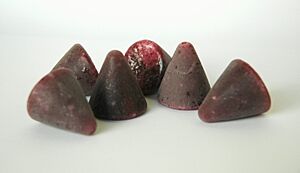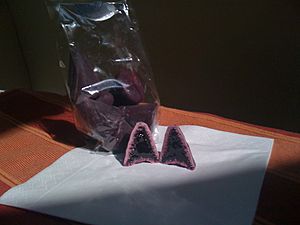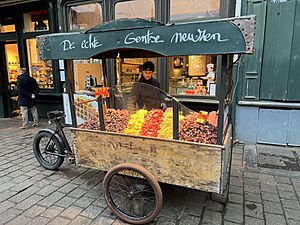Cuberdon facts for kids
A cuberdon is a special cone-shaped candy from Belgium. It is a very popular treat, especially in the city of Ghent. People in Belgium often call it a "nose" (neus) or "little nose" (neuzeke) because it looks a bit like a human nose. In French, it can also be called a "priest's hat" (chapeau-de-curé).
Traditionally, cuberdons have a firm outer shell made from a type of gum, and a soft, gooey inside. The inside usually tastes like raspberry and is purple. However, today you can find cuberdons in many different colors and flavors!
These candies are usually about 2.5 centimeters (1 inch) wide. They weigh around 10 to 18 grams. The outside is quite hard, but the center is soft and jelly-like. People even use cuberdon flavor in other foods. You might find cuberdon-flavored ice cream, sauces for desserts, or even cookies.
Cuberdons don't stay fresh for very long. After about three weeks, the soft inside starts to get hard and sugary. Because they don't last long, you usually only find cuberdons in Belgium. A special agency of the Flemish Government has officially recognized the cuberdon as a unique regional product.
How Cuberdons Began
People have a couple of ideas about how the cuberdon candy first came to be.
The Clergy Member's Idea
One idea is that a religious person living in the city of Bruges created it. This might explain why some of its old names mean "cleric's cap" or "young nun's belly-button."
The Pharmacist's Discovery
Another story says that a pharmacist named De Vynck in Ghent accidentally invented the cuberdon in 1873. Back then, medicines were often made into syrup to help them last longer. One day, the pharmacist was checking a batch of medicine that didn't turn out right. He noticed that it had formed a hard crust on the outside, but the middle was still liquid. This gave him the idea to use this trick to make a new kind of candy!
See also
 In Spanish: Cuberdon para niños
In Spanish: Cuberdon para niños




